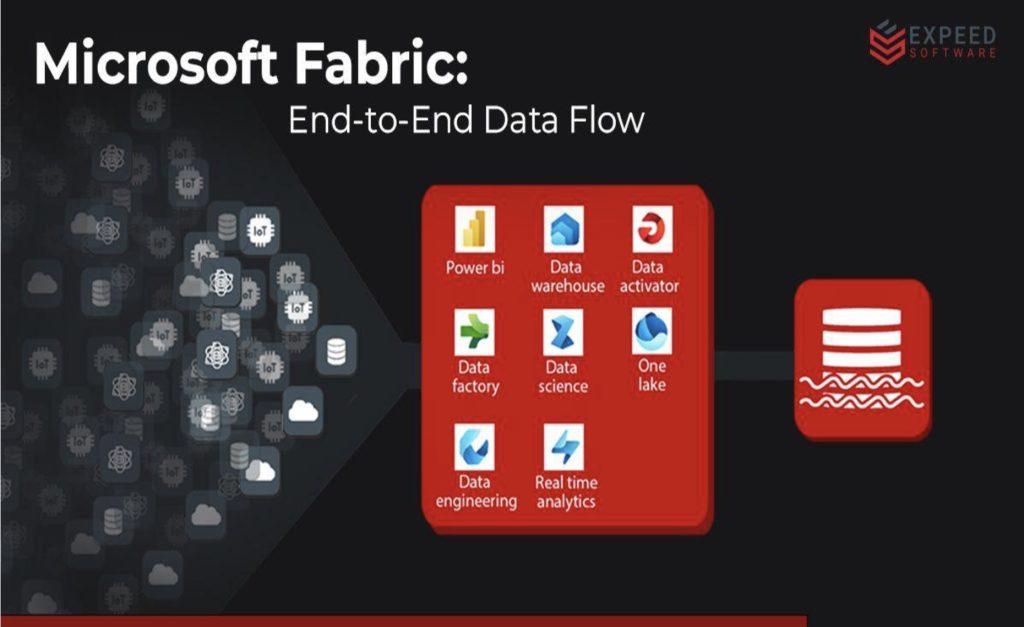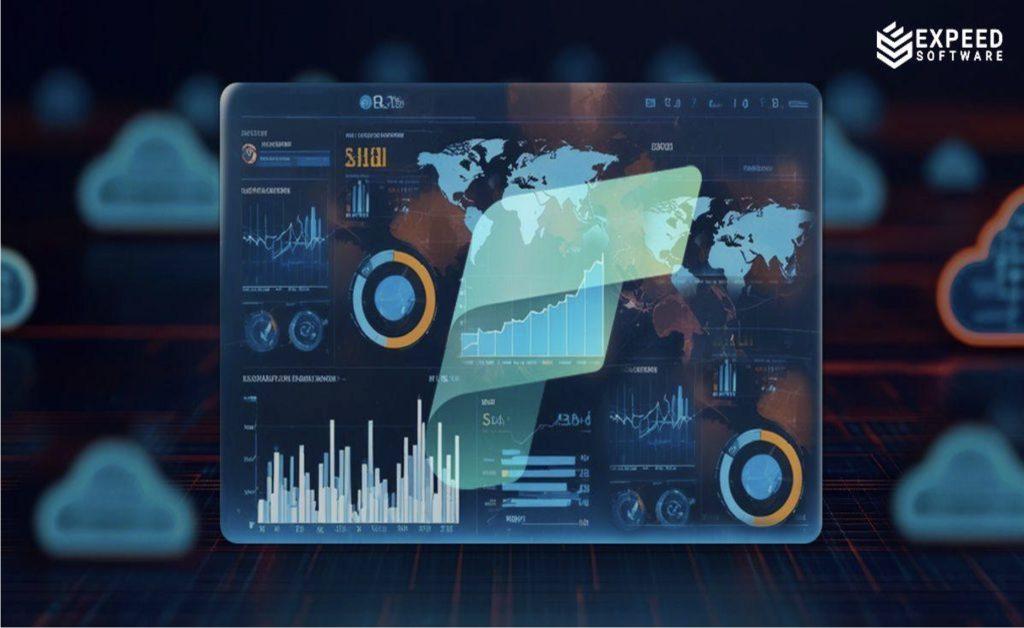In the fast-paced world driven by AI, data is more than just an asset for businesses, it’s the backbone of innovation, decision-making, and competitive gain. Yet, businesses today find it hard to manage data effectively. The volume of data, hybrid cloud setups, fragmented tools, and the never-ending need for real-time insights have made data management a puzzle of complexity. At Expeed Software, we have seen these challenges overwhelm IT teams and helped them overcome the situation. Here is where Microsoft Fabric steps in as the game-changer, providing a single analytics platform that breaks data silos and allows businesses to simplify their operations.
The Growing Data Challenge for Enterprises
Enterprises face an unusual storm of data management requirements in every direction. This can sprout from IoT logs, structured databases, and real-time customer interactions distributed across hybrid and multi-cloud environments. And the challenge in this case is to transform this disparate data into actionable insights. Enterprises would also have to balance speed, cost, and governance simultaneously. Legacy data solutions only introduce complexities, such as increased costs, governance challenges, and slower insights. For IT managers, this is a headache of patching together discrete systems, while business leaders demand real-time analytics to drive smarter decisions.
Forrester’s findings reveal the statistic that between 60% and 73% of all enterprise data is going unused through analytics. No business can afford the gap when insights and agility must not be sacrificed. With machine learning and AI depending on accessible, structured data, this isn’t merely an opportunity missed, but a strategic risk.
Microsoft Fabric – Unifying Data for Smarter Insights

Microsoft Fabric is an end-to-end AI-driven data analytics platform that redefines data management. The platform assists in streamlining the entire data life cycle into a single unified ecosystem. Moreover, Fabric is not just a solution, but a paradigm shift that enables businesses to eliminate complexity by removing siloed data systems. This can make business operations quick, easy, and efficient. Let’s explore how Fabric’s core experiences solve data challenges with accuracy.
- Data Factory: Streamlined Ingestion and Integration
Data Factory evolves into a modern ETL powerhouse with over 200 connectors, pulling data from anywhere—on-premises SQL servers, cloud-based CRMs, or real-time streams—into a unified pipeline. For IT managers, this eliminates manual integration woes, enabling you to expose data as REST or GraphQL endpoints effortlessly. Imagine cutting integration timelines dramatically while ensuring data flows seamlessly into your analytics stack.
- Analytics Data Engineering: Preparing Data at Scale
Handling complex data requires a robust preparation process. Analytics Data Engineering harnesses Apache Spark to transform raw, messy datasets into structured, actionable formats. Whether deduplicating customer records or aggregating IoT telemetry, this experience scales effortlessly, amplifying your team’s capacity without requiring an army of specialists. It’s enterprise-scale efficiency, simplified.
- Analytics Data Science: AI Made Accessible
AI isn’t just for tech giants. Analytics Data Science brings machine learning within reach, letting you build, train, and deploy models directly in Fabric. Think predicting customer churn or forecasting demand—no advanced degrees are required. For IT leaders, this democratizes AI, empowering your team to deliver predictive insights without external dependencies.
- Analytics Data Warehousing: Unified Storage and Querying
Stop choosing between a data warehouse and a data lake. Fabric’s Analytics Data Warehousing combines high-performance SQL with open formats like Delta Parquet, all stored in OneLake. This centralized hub unifies sales data, operational metrics, and customer insights, simplifying architecture and cutting storage costs.
- Real-Time Intelligence: Acting on Data in Motion
In an AI-driven world, speed is paramount. Real-time intelligence ingests and analyzes streaming data—like IoT pings or website clickstreams—with near-zero latency. IT managers can configure alerts (e.g., “notify ops if inventory dips below threshold”) or power live dashboards, all without stitching together complex stacks. It’s a lifeline for time-sensitive decisions.
- Power BI: Insights That Speak Business
Power BI in Microsoft Fabric goes beyond basic reporting—it helps businesses visualize and understand data. Seamlessly integrated with Microsoft 365, it transforms raw data into interactive, AI-powered dashboards that decision-makers can use instantly. For IT teams, this means fewer manual report requests, while business users gain the power to explore data independently.
- OneLake: The Foundation of Unity
OneLake is the backbone of Microsoft Fabric—a fully managed, SaaS-based data lake designed to eliminate data silos. Instead of managing separate storage for different tools, OneLake provides a single, shared repository accessible across all Fabric workloads. Think of it as OneDrive for enterprise data, simplifying security, sharing, and compliance while keeping everything in one place.
- Fabric Databases: Bridging Transactional and Analytical Worlds
Newly introduced, Fabric Databases unite transactional and analytical workloads in a developer-friendly environment. Whether it’s an Azure SQL Database or a mirrored instance from another system, this feature makes operational data instantly available for Fabric’s analytics engines. For IT, it’s a seamless way to integrate live business data into your AI and analytics workflows.
Why This Matters in an AI-Driven World
AI demands data quality and availability—areas where enterprises often falter. Fabric’s unified approach, enhanced by Azure OpenAI Service and Copilot, embeds intelligence at every layer. Your team can query data naturally (“Show me Q1 trends”), auto-generate pipelines, or build ML models conversationally. This isn’t futuristic fluff; it’s a practical edge that sharpens your competitive stance. A retailer could predict stock needs in real time, while a manufacturer optimizes maintenance—all without a sprawling tech stack.

From a business perspective, Fabric slashes the total cost of ownership. By tapping one pool of compute power across workloads, you minimize waste—translating to predictable budgets and happier CFOs. Plus, with Microsoft Purview’s built-in governance, you’re audit-ready without the compliance scramble.
The Expeed Edge: Getting Fabric to Work for You
At Expeed Software, we’ve helped companies navigate this data transformation for many years. Microsoft Fabric is not just a technology, it’s a strategic enabler. However, success depends on how you execute the same. We assist you in evaluating your data surrounds, prioritizing use cases (e.g., real-time analytics vs. legacy reporting), and deploying Fabric in phases tied to your objectives. Whether migrating from a patchwork of tools or starting from scratch, our team spans the technical and business chasm, ensuring IT and leadership move forward together.
Summing Up
The complexity of data businesses face in the modern era isn’t slowing down, rather, it’s speeding up. Microsoft Fabric provides a lifeline – one platform that streamlines management, speeds up insights, and fuels AI without busting budgets or teams. For IT leaders, this is truly a time to go from firefighter to strategist, giving your enterprise the data foundation it needs to thrive in an AI economy.
Ready to untangle your data mess? Let’s talk. At Expeed, we’re not just consultants, we’re partners in building your data-driven future.



